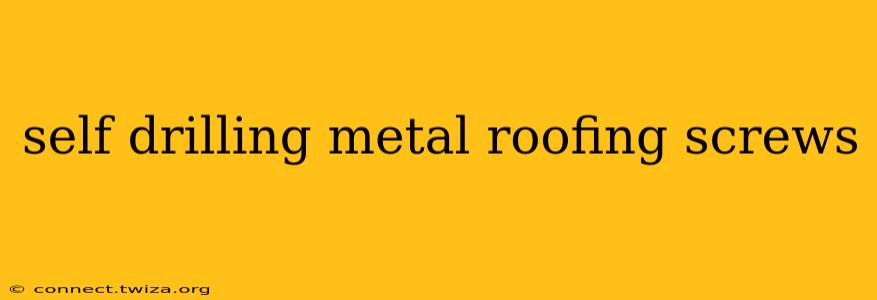Self-drilling metal roofing screws are a crucial component in securing metal roofing systems. Their unique design eliminates the need for pre-drilling holes, saving time and labor while ensuring a secure and weathertight seal. This comprehensive guide will explore everything you need to know about these essential fasteners, from choosing the right type to proper installation techniques.
What are Self-Drilling Metal Roofing Screws?
Self-drilling metal roofing screws are specifically engineered fasteners designed for use with metal roofing materials. Unlike standard wood screws, these screws possess a sharp, pointed tip that pierces the metal roofing sheets, creating its own pilot hole as it drives into the underlying structure. This eliminates the need for pre-drilling, a time-consuming step that can significantly slow down the roofing installation process. They typically feature a coarse, aggressive thread for optimal grip and holding power in various metal types. The screw's head is usually designed to create a watertight seal against the elements.
Types of Self-Drilling Metal Roofing Screws
Several types of self-drilling metal roofing screws exist, each tailored to specific needs and applications. Common variations include:
- Different Head Types: Popular head styles include pan heads, button heads, and hex heads, each offering varying degrees of aesthetic appeal and functionality. Pan heads are common for their ability to sit flush or slightly recessed, minimizing water buildup.
- Material: Most self-drilling screws are made from hardened steel, providing excellent strength and durability. Some may have specialized coatings like zinc or stainless steel for enhanced corrosion resistance, crucial for long-lasting performance in harsh weather conditions.
- Thread Design: The thread design significantly influences the screw's holding power and ability to penetrate different metal thicknesses. Coarse threads provide better grip in thinner metals, while finer threads offer greater holding strength in thicker materials.
- Sealants: Many self-drilling screws incorporate a rubber or EPDM washer under the head, creating a weatherproof seal to prevent leaks. This is especially important in regions with heavy rainfall or snowfall.
What is the difference between self-tapping and self-drilling screws?
While often used interchangeably, self-tapping and self-drilling screws have subtle differences. Self-tapping screws form their own threads as they are driven into the material, while self-drilling screws create their own pilot hole and may or may not form their own threads depending on the design. Many metal roofing screws are self-drilling and self-tapping, combining both functions for efficient installation.
What size self-drilling screw should I use for metal roofing?
The appropriate size depends on the thickness of the roofing material and the underlying structure. Consult the manufacturer's specifications for your specific roofing system. Using screws that are too small can lead to leaks, while screws that are too large can damage the roofing material. Always choose screws that are appropriate for the gauge of your metal roofing.
How many self-drilling screws do I need per square foot of metal roofing?
The number of screws per square foot varies depending on the roofing material, wind load requirements, and local building codes. Always follow the manufacturer's recommendations and adhere to local building codes for optimal performance and structural integrity. Underestimating screw density can compromise the roof's ability to withstand high winds.
Are self-drilling screws suitable for all types of metal roofing?
While self-drilling screws work well with many metal roofing materials, such as steel and aluminum, it's crucial to check the compatibility with your specific roofing material. The screw's point and thread design must be appropriate for the metal's thickness and hardness. Using the wrong type could lead to stripping or damage to the roofing panels.
Installation Techniques for Self-Drilling Metal Roofing Screws
Proper installation is crucial for a long-lasting and leak-proof roof. Here are key steps to follow:
-
Preparation: Ensure the metal roofing sheets are correctly aligned and positioned. Clean the surfaces to remove any dirt, debris, or contaminants that could interfere with the screw's ability to penetrate the metal.
-
Screw Placement: Use a consistent spacing pattern as recommended by the roofing manufacturer. Overlapping screws are essential for creating a secure seal and preventing wind uplift.
-
Driving the Screw: Use a high-quality impact driver with the correct bit size to avoid stripping the screw head. Apply even pressure to drive the screws straight and avoid damaging the roofing material. Avoid over-tightening, which can also damage the materials.
-
Inspection: After installation, visually inspect the roof for any loose screws or gaps. Address any issues promptly to ensure a weathertight seal.
Choosing the Right Self-Drilling Metal Roofing Screws
Choosing the correct self-drilling screws is vital for a successful and long-lasting roof. Consider these factors:
- Metal Type: Ensure the screws are compatible with your roofing material (e.g., steel, aluminum, copper).
- Gauge of Metal: Select screws appropriate for the thickness of your roofing panels.
- Weather Conditions: Choose screws with corrosion-resistant coatings for areas with harsh weather conditions.
- Local Building Codes: Adhere to all relevant local building codes and regulations.
By understanding the various types and installation techniques, you can select and install the ideal self-drilling metal roofing screws for a secure and durable roof that stands the test of time. Remember to always consult with a qualified roofing professional for complex installations or if you have any doubts.
